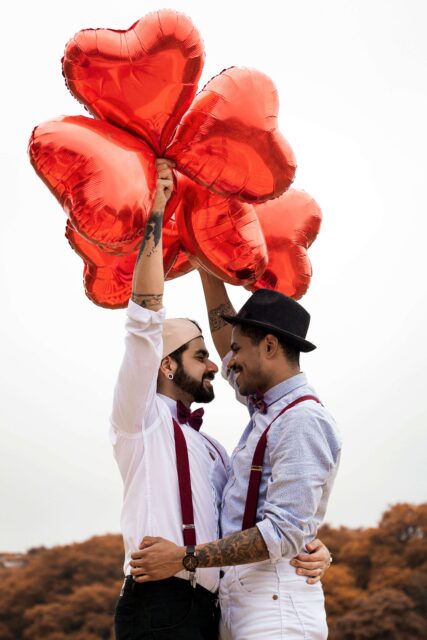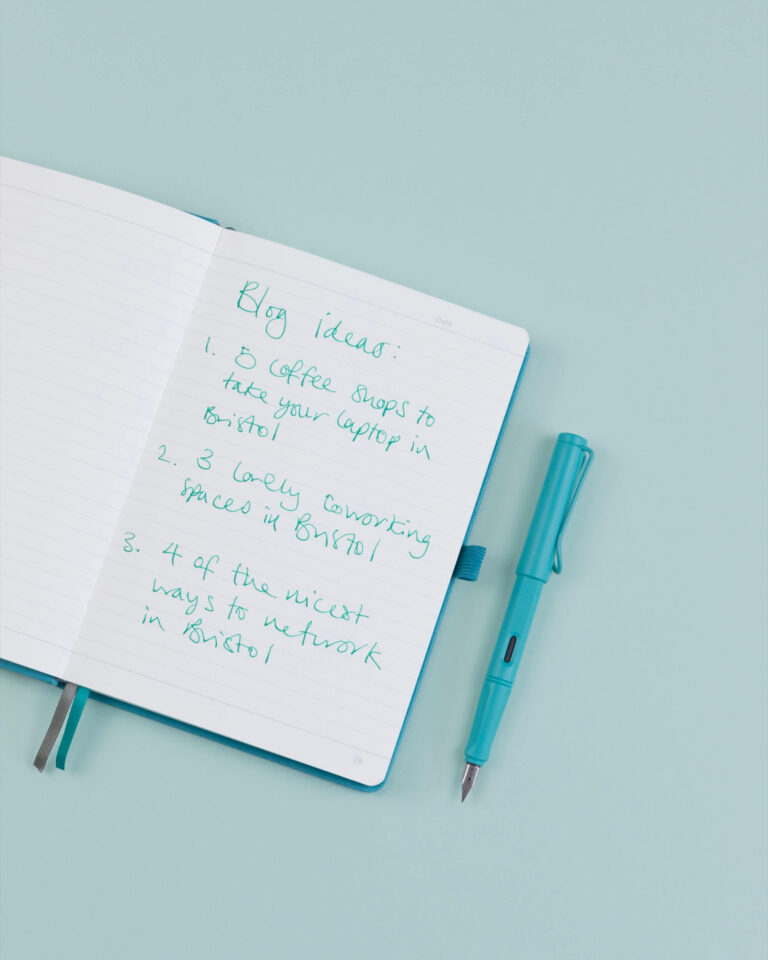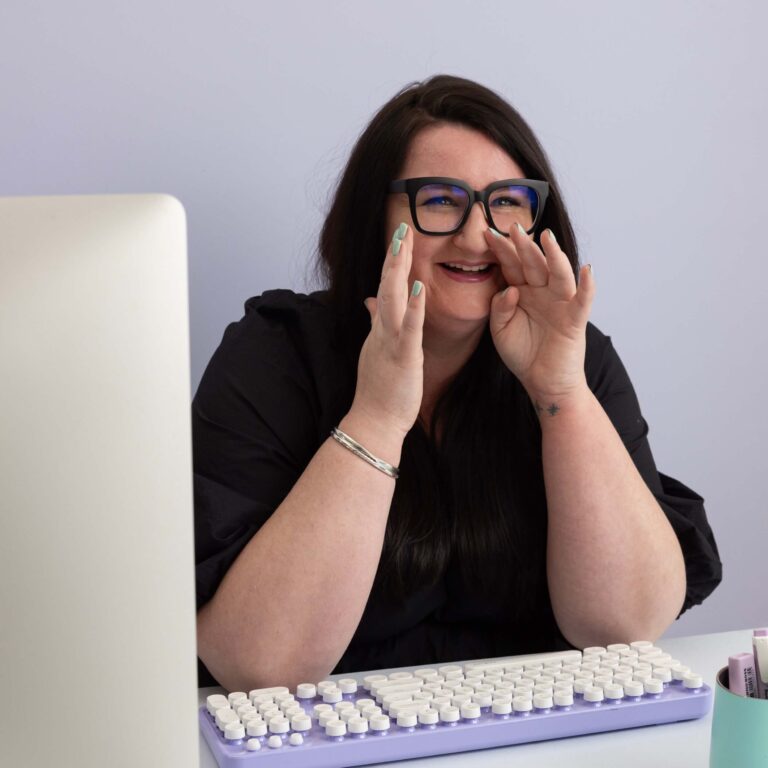This blog was inspired by a chat with a lovely group of small business owners in Bristol a little while ago. They were in different industries, a mix of product- based and service- based, and they all had something in common. I’ve summarised our chat here in these four sentences:
“I care about the LGBTQ+ community and working with LGBTQ+ people. But, I am not part of the community personally, and I have not mentioned anything about being LGBTQ+ inclusive anywhere in my marketing. Mainly, I’m scared of saying the wrong thing or putting my foot in it, so I just stay quiet. Then I feel bad about it because I’m not actively including everyone.”
Does this resonate with you?
As a copywriter, I know there are loads of ways to subtly but clearly show your inclusive business values in your copy. There are also tons of ways to use design and photography to communicate you’re a safe business for LGBTQ+ people.
But howwww?
I’m a heterosexual cis woman in a cis- het relationship, and although I am an ally, I am not part of the LGBTQ+ community. So, while I can give some marketing and copywriting advice, I wanted to speak to people who are LGBTQ+ to understand exactly how small businesses can be inclusive. You’ll find links to the (very kind) contributors’ websites in this blog.
Here’s their advice and opinions, with a few of my copywriting examples chucked in.

Be confident: Highlight your LGBTQ+ values, and be unapologetically you
“Being professional” in your business does not mean “have no personality or opinions”. Your business is YOU, and “being professional” is whatever the hell you want it to be. Stating your values, beliefs, and opinions as a business owner is actually brilliant. Instead of shying away, boldly stand up for who and what you care about.
Not only will you inspire other business owners to show their personalities, but consumers want to buy from business owners who share their values.
When you’re authentically you in your marketing, and supporting LGBTQ+ people, you’ll naturally repel people who aren’t your ideal customer and you’ll attract people who are.
Often, small business owners fear ‘putting customers off’. But, let’s be honest, if someone’s put off from working with an inclusive business, they’re probably not inclusive themselves. Perhaps they’re even homophobic, biphobic, or transphobic. And you don’t want to work with them anyway, do ya?
Small (but powerful) ways to show your small business is LGBTQ+ friendly
You can be loud and proud, or strong yet subtle, but there are so many ways to demonstrate your business is LGBTQ+ inclusive.
Lucy Knott, a photographer from Glasgow, explained her view. “I appreciate small business owners being aware of their LGBTQ+ customers and not just around pride month. Something as easy as showcasing the pride flag in your business can instantly make the LGBTQ+ community feel safe and welcomed. This could be a sticker on the front door of their store, or on the footer on their website, and emoji in their Instagram bio, or wearing an LGBTQ+ pin on your lanyard, or even having a small sticker on a name tag”.
These suggestions from Lucy are seemingly small, but they’re powerful, deliberate signs that you’re thinking about your LGBTQ+ customers.
Likewise, sharing information about yourself can encourage customers to share with you. Alice Rowan, a website copywriter from Cheltenham says, “display your pronouns! Include them in your email signature, your Zoom name, in your social media bio”. Once you’ve shared yours, customers may feel comfortable sharing theirs. You can ask for pronouns in enquiry forms, so you know exactly how to address prospective clients (more on this in section part 4).

Be vibrant: How to show your business is LGBTQ+ inclusive with photography
Having images of many different types of people in your photos is a great sign you’re an LGBTQ+ friendly business. “I love seeing diverse bodies and gender expressions in marketing content”. Ines Hinojo- Moulin, freelance translator and inclusive communication expert told me.
This can be especially important for wedding businesses or family- related businesses. Lucy Knott is a photographer, and she knows how powerful images can be. “I love to see images of same sex couples on landing pages and galleries. This straight away grabs my attention and tells me that the business is inclusive”.
So, there’s no question here. Featuring LGBTQ+ people in your photos is important to help your customers feel welcomed and safe. But why? Alice Rowan explains:
“Making an effort to include photos of diverse people instead of just straight, white, slim, able- bodied folks is a big green flag. Many of us in the LGBTQ+ community care deeply about diversity, inclusion, and representation across marginalized communities.”
[The quiiiiickest little note to mention that if you’re using models, even if they’re your customers or loyal members of your community, you need to pay them. I know you would anyway, because you’re nice and ethical, but I thought I’d mention it.]
If you can’t find models, don’t worry- Ettie Bailey- King to the rescue! She’s an inclusive and accessible communication consultant, and her suggestion is to use quality stock imagery. “It’s a great idea to use to use images showing a wide range of people that happen to be lots of different genders, gender presentations, and sexual orientations. This obviously depends a lot on the nature of your work, but check out this example of a stock collection that I like”.
What to do if you can’t use images of diverse people in your business?
I get it. It’s just you, a website, and a cup of ambition, working 9 ‘til waaay after 5. So, the images kinda need to be of you. If you can’t take images of a diverse range of people because it’s not relevant to your ‘solopreneur’ business, it’s time to get creative.
- Put up some pride bunting up in the background of your workspace (and then keep it up because it’s cheerful and fabulous).
- Wear a t-shirt with an inclusive statement on, like “love is love”, or in the colours of the trans flag, or another garment that feels authentic to you.
- Hold a mug with “not gonna hide my pride” on it, or a slogan that speaks to you.
- Wear a rainbow lanyard, switch out that old lanyard for something far more proud.
- Hold/ wear/ show stationery, or a cute enamel pin, or an accessory, or something you love, in rainbow colours.
Super quick tip, you could buy all these things and more from LGBTQ+ small businesses.
Failing all of this regularly share social media posts and reels from LGBTQ+ business owners to your audience.

Be clear: How to show your business is LGBTQ+ inclusive with copy
Making your messaging clearer and more inclusive benefits everyone. A great first step is ‘to use gender neutral language in all marketing”, Alice explains.
If you’re not confident with words, don’t worry. You can work with a copywriter, just like you’d work with a photographer. Alternatively, you can use a sensitivity reviewer, as Ines told me, “more and more businesses ask sensitivity reviewers to check their content and I think it’s a good call, because of course, you can’t know everything, but when your sales depend directly on the way your clients identify or not with your brand, it’s important to talk to everyone”.
Ask for recommendations for a sensitivity reviewer within your network, or contact one of the generous contributors in the article.
What to write about being LGBTQ+- inclusive as a small business owner?
Here are some short statements to you could use to describe your business. It’s a good idea to use the one/s which feel authentic to you, your business, your values, and your tone- of- voice.
- “I/ we/ [business name] proudly works with everyone
- TERF- free zone
- Love is love
- F*ck homophobia
- Trans rights are human rights
- Families come in all shapes and sizes
- Discrimination- free zone
- Respect everyone
- LGBTQ+ friendly space
- Proud ally to the LGBTQ+ community
Short statements like the ones above can be popped lots of places: in your social media bio, in your email signature (near your pronouns?), on the footer of your website, in hashtags on social media, in a values banner on your website about page, and in your captions on images.
You can go into far more detail in other places in your website copy:
- Testimonials/ reviews
When someone reviews your business and reference how they’re LGBTQ+ and they love your products/ services/ business- put this prominently on your website and social media. - About page
Include a whole section about your values on your website, including the words “LGBTQ+ inclusive”. - Inclusivity statement
Just like companies which have ethical and/or sustainability statements, write what inclusivity means to you, and how your business is inclusive. - Blogs
Write blogs about topics which would be interesting to LGBTQ+ people. Such as: “6 LGBTQ+ friendly wedding venues in Wales”, or “Fierce and fabulous: five incredible LGBTQ+ artists on their craft” (a great topic if you’re a picture framer, a gallery, or an interior designer), or ‘4 LGBTQ+ jewellers/ designers/ authors/ you need to know about’. - Case studies
Go in depth on a recent client experience. Share the before/ after, or what happened when you and your LGBTQ+ client worked together. Obviously get permission from your customers before publishing this!
How to have an LGBTQ+- friendly tone of voice for your small business.
It’s easy to over think tone of voice but the trick is to keep it simple. Ettie recommends using “casual, everyday inclusive language. Stuff like: “bring your partner”, “the person in your life”, “share this with your spouse”, “for many of us who live with a partner”, “if you and your other half are interested”.
Some businesses rarely, or ever, need to mention gender or sexuality. Others make references to it all the time:
- Wedding businesses:
Lucy explained, “I would never consider working with a supplier which is not inclusive with their copy and only refer to the happy couple as husband and wife”.If you are writing about a wedding where a man and woman have married, then of course use “bride and groom” or ‘husband and wife’. But, if you’re writing about your general wedding services, or weddings overall, don’t default to the idea there’s a man and a woman. Instead, use “happy couple”, “spouses”, “partners”, “married couple”, “newly- weds”, “nearly weds”. Use “Mrs & Mrs”, “Ms & Ms”, “Mx & Mx”, or “Mr & Mr” only when you’re sure how the couple identifies.

- Parenting/ family businesses:
Not every family looks the same, so don’t assume your customers’ families have a mum, a dad, and a child. Use language like “caregiver”, “parent”, “kids”, “adults”, “grown-ups”. Don’t attach gender to any jobs, such as “mummy does cleaning”, or “daddy does building” because this reinforces gender roles in an unhelpful way. Instead, use sentences like “grown-ups can help kids with…”.When you are talking about specific products or people, then it’s a good idea to be specific, and it’s absolutely ok to use “mum” and “dad”. Remember, this is about including everyone, rather than excluding. A good example of this is to say “pregnant women and people”, rather than just “women”.

A last snippet of tone of voice advice- don’t use terms you don’t understand. Referencing LGBTQ+ culture or slang can work brilliantly, but only if you’re using it correctly and not being accidentally offensive. Never be performative. Don’t do something just because you think it’ll win people over, or “look good”. This is called pride- washing and it’s gross. Consumers are incredibly alert to inconsistencies in messaging, and they can tell if you’re being inauthentic.
Be considerate: Only ask for the data you actually need to do your job
You probably have a contact form where potential customers can make an enquiry. You might also have a form for newsletter sign ups.
Asking the right questions can mean a customer can feel included and safe. Asking the wrong ones can make someone feel judged or unsafe. Ettie told me, “business owners should not ask for unnecessary data”. You probably don’t need more than someone’s name, pronouns, and contact details to work with them.
Additionally, using correct language is very important. Ines Hinojo- Moulin shared “I’ve seen organisations only have “man”, “woman” and “prefer not to say” listed, making non-binary people invisible. And I’ve seen others have “man” and “trans man”, when “cis man” and “trans man” would have been way better”.
“If you really have to ask for gender”, says Ettie, “make sure the fields are accurate. I’ve seen some hideous examples out there, like websites that think “trans” is a gender! If you’re a trans man, for example, then being a man is your gender. Being cis or trans is not a gender. Include a range of common genders including non-binary, genderfluid, etc, and include a write-in field so customers can write what they feel comfortable with”. Not sure on what cis and trans actually mean? Check out this blog from Ettie.
A golden rule is to never make assumptions, and to use gender- free language wherever possible. Jane Bell, under the handle of @discodialogdiva on Threads, shared, “the top failing of small businesses is misgendering. If you are not sure what to say when you see someone, then just say ‘what would you like?’ or ‘how can I help you’, with no ‘sir’ or ‘madam’”.

Be informed: Places to learn about LGBTQ+ inclusivity
If you’d like more tips on creating an LGBTQ+ friendly business, for employees and customers, check out these resources.
- Stonewall: 5 ways to kickstart LGBTQ+ inclusion at work
- Stonewall: Build a workplace that works for LGBTQ+ people
- Google for Small Business: Tools and resources for LGBTQ-friendly businesses
- Harvard: How To Tell if an Employer Is LGBTQ+ Friendly
- Wales TUC Cymru: 10 steps towards LGBTQ+ inclusive workplaces
- Think with Google: Pride means business: The importance of creating LGBTQ+ inclusive spaces in store and online
- Queerify: LGBTQ+ Safe Space Certification
- Practical ways to support trans folks
Thank you so much to the superb contributors to this article. Please visit their websites, give them a follow, and mention them to your networks.













